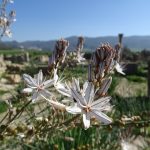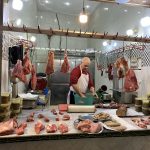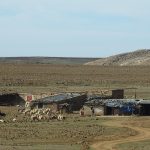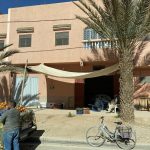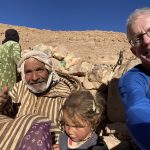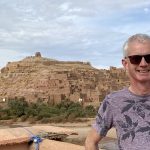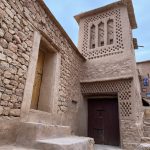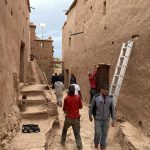Wednesday January 31, 2024
Last night I arrived in Casablanca, Morocco. At the airport I bought a local SIM card and took the train to Casa Voyageurs. The hotel is across the square and after checking in I visit a cafe that is packed. Morocco plays against South Africa for the Africa Cup. Everyone is on the edge of their seats when Morocco gets a penalty and the chance for an equalizer… missed. To make matters worse, South Africa scores again and with a few minutes to go in regular time, ⅔ of those present leave disappointed.
This morning I take bus number 11 to the lighthouse. The rough sea crashing on the rocky coast is beautiful, the lighthouse less so. I continue walking and follow the Boulevard de la Corniche to the Hassan II Mosque. One of the few mosques that can be visited by tourists. My walk continues through the old medina with its narrow alleys and shops and past French colonial buildings.
In the evening I meet the rest of the group, 7 Canadians, and the next day the journey begins by train to Rabat. The French influence is clearly visible here in the buildings and avenues with palm trees. The Kasbah de Oudayas, the walled city with nice alleys and white houses, is beautifully situated by the ocean and the river. The Jardin Andalou is a green oasis in the city. We see some modern buildings, such as the Grand Theater and the Mohammed VI Tower, before we visit the Hassan Tower and the Mausoleum of Mohammed V. The large square with a sea of columns is a reminder of times gone by. Later we take the fast train to Meknes.
On Friday we follow the local guide through the old city. The oldest part is being completely renovated and unfortunately cannot be visited. The enormous water basin is almost dry, but the last lake contains quite a few storks. Beautifull sight. The walls of the city are being renovated and we see men busy everywhere. We walk along the wall of the Royal Palace. Continue between endless high walls until we arrive at the medina. We walk further into the city and now pass the world famous gate which, unfortunately, is behind the scaffolding with a photo print. Across the square, where the artists normally perform, and through the narrow alleys of the old town.
In the afternoon we go to Volubilis, the ancient Roman city. Great site. So much to see and the guide tells a lot, but not annoyingly. We walk around the site, see several mosaics and many foundations. Earlier today we heard that many of the columns and other marble objects from this site were used to embellish the mosques, palaces and squares. A shame, but unfortunately not unusual in the past. The excavations have uncovered plenty and the French in particular have rebuilt part of the city, using the old debris. We see the Gate of Tangier, the remains of the aqueduct, the Arch of Caracalla and the Capitol. All impressive. At the site the fields are flowering, yellow, orange, white and blue. So nice. Back in the van and through the mountains and the olive fields to Fes.
After a good night’s sleep, another local guide will take us in tow today. The first stop is at the Royal Palace. That means we see the gate, which has been beautifully restored. In front of the gate there is a huge square with beautiful trees, just next to the Jewish quarter. We walk down the road past Moorish houses with overhanging balconies. From the mountain near the south tower, Borj Sud, we see the old town and the white tower and green roofs of the oldest university in the world in the distance. In the old town we meander through the maze of narrow alleys. Sometimes less than a meter wide, often also covered with a roof or a house. It’s special how everything weaves together. We see a square where copperware is forged and of course the famous tannery, where the leather is still treated in the large round baths. We take a look inside Al Quaraouiyine University, the oldest university in the world. We are not allowed to enter because it is also a mosque, how so it is called University? Quite sad. We see a museum, which used to be the old teaching building, and a hotel for traders, Musée et Foundouk Nejjarine des Arts, from the past. Beautiful carvings and tiling. Another look inside at the Mausoleum of Moulay Idriss II. Heathens are not welcome here either. Before dinner, I have a drink with Rosalie on a terrace on the boulevard, Avenue Hassan II, enjoy the sun and watch people.
On Sunday we drive through a beautiful landscape into the mountains, the Middle Atlas Mountains. Small villages and beautiful views. Continue until we stop in the mountains at Ifrane, a village completely in French Alpine style. Very funny. Here the storks nest on the roofs and we enjoy the sun in the park. Absolutely great. Picnic in the mountains along the way. At Midelt the host walks with us through the orchards and along the river. We cross the stream twice and the last time we have to take off our shoes. Then through the village and a high five with a little girl. The ladies of the village buy clothes here, brought from the city. A local band will perform at dinner and there will be dancing.
The next day we travel to Auberge de la Source, where we leave our luggage behind and go into the Sahara with camels. Bring a daypack and go. We bump into the dunes for an hour before we stop. Craig and I walk a little further up the dunes to get a better view. The sunset is fantastic and we take some more pictures. Awesome. Back on the camels and to the tent camp on the edge of the dunes. After dinner, we spend some time by the campfire. Here is a young Belgian couple. They both study in Leuven and want to become engineers. Lore does architecture and building physics. How coincidental and then it turns out that they are both scouts also. We have a nice chat and later walk into the darkness to admire the Milky Way.
On Tuesday we start with a camel ride for the sunrise. After breakfast we drive west. We stop at an old irrigation system in the form of tunnels with wells every 15 m below the surface of the desert near Fezna. An entrance has been made so that we can also look underground, about 10 m deep. Very interesting. Then onwards and then a stop and a visit to Ksar El Khorbat, with the Oasis Museum. Very funny town, with mud-straw houses and covered streets. School has just ended and we have to high-five all the kids. Still fun. The museum tells about life in the area and even something about the Jewish community that used to be well represented here. Now almost everyone has left for Israel, but of course they are still very welcome in Morocco. We don’t know what to think of it. Israel’s 6-day war is also mentioned here, which our, generally well-informed, guide and some group members have never heard of. The Western Sahara and the relationship with Algeria is also a special one, according to the Moroccan reading. We don’t ask questions and move on. 1.5 hours later we arrive in the mountains near Tinghir. We still have 3 hours until dinner and I decide to take a walk along the river to the village. Beautiful almond trees in full bloom and beautiful paths where you can walk through the fields. Always the high rocky mountains on both sides of the valley. Beautiful. The locals are very friendly and through the village I walk past houses made of mud and straw that are abandoned and semi-derelict. Back at the hotel, part of the group is drinking wine on the roof terrace and I can’t turn that down. Then dinner by the fire and that is actually quite nice. The fire, because the food is fantastic and plentiful again.
The next morning Craig, Frank and I leave for the hike through the famous Todgha Gorge. The entrance to the valley is narrow and steep, with the river on the right and a road on the left. We soon leave civilization behind and enjoy the beautiful landscape. So rough. We climb higher and higher over rocky paths. Every now and then we come across other hikers and some with a dog. Higher up we see a herder with black goats. Beautifull sight. Take a rest and then continue. We have the choice to drink tea with a local nomadic family and we don’t refuse. The host, Hamed, is 82 and lives here in a kind of hand-dug caves with his second wife (his first wife is deceased) and his granddaughter, Amine. The old man is super hospitable and gestures for me to sit next to him. I share some dates I brought with him and he pours the tea that his wife has made for us. The granddaughter, about 4 years old, sits between me and him and shows off her doll, a rabbit with a veil. There are a few week-old goats that have to be fed by hand. A kind of doll for the little girl. Wonderful to be welcomed like this and to be able to enjoy the rocky landscape. We say goodbye and I give him the small wooden clogs with Delft Blue. I’m not sure if he can connect it to the Netherlands, but he appreciates it anyway. Oh well, and otherwise his granddaughter can play with it. We now walk further down. Back to the valley. More beautiful views and eventually we reach the village via the almond trees and the river.
After the night, we cross the bridge and get back on the bus. The route goes through the mountains and through the valley between the mountain ranges. Beautiful. We regularly pass a village and green oases with many palm trees along the river. Here and there an old kasbah, the mud castles rom bygone times. We drive past a silver mine and on, until we reach Ouarzazate. On the roof terrace of the hotel we enjoy a fresh ginger tea and a view of the old town Ait Benhaddou. On the mountain on the other side of the river, about twenty people are now busy with a film. For hours and apparently it has to happen at sunset. We cross the river and walk through the gate, past the fields and into the main gate through the city. Past shops and through the streets of the old city. Top. At the top of the mountain we enjoy the view and then we go through the old mud town back towards the river. Along the way we see a team decorating the streets for the film. New leather that is made old with paint and the sand walls get a little more color.
On Friday we arrive in a village, we can leave our luggage and take a small daypack with us. This means that the backpack goes on the donkey. In the rain we walk up through the beautiful walnut trees. The rain is more drizzle and luckily it’s not too bad. The donkey has now also been replaced by a car, so it’s actually not too bad. We walk for 45 minutes through the orchards and the village. Then we cross the river and see the high mountains, including the highest in Africa, with snow on top. Still beautiful. We receive a friendly welcome and guide Mohamed tells us that his father-in-law has a piece of land here. Earlier today we drove through Imil and saw large tent camps. Still from the earthquake that occurred here a year earlier. The fireplace is burning in the hotel and we enjoy the warmth.
During breakfast we hear that the road is blocked for traffic and we have to wait a while. Yesterday’s rain loosened a lot of sand and rocks and the road appears to be quite strewn with them. We walk through the village along the road to the next village. Beautiful views and now that the sun is shining, we see beautiful snow-capped mountain peaks. The village is quite basic in places. We continue walking and occasionally have to go around the boulders on the main road. At the waterfall there is a large tree stump over the road. The local moped is helped to get past it. This later also applies to the 4×4 in the village, which only has a few centimeters of clearance to get past the enormous boulder. Then by bus in the direction of Marrakech. On the way we stop for lunch at Mohamed’s house. His mother feels honored and has made something very tasty food together with his shy wife. We will be on the coast in Essaouira around 5 p.m. Just outside the gate of the old center, the luggage is transferred to a handcart and we can go to our hotel in the old center.





















